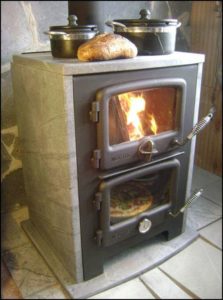
Vermont Bun Baker 750
By George Harvey
Many people who cook with wood stoves absolutely love them. It is an entirely different experience, in which the stove itself almost seems to be a living thing, with its own soul, the goodness of which it imparts to its food in some mystical fashion. Those I have talked with often agree with me on this.
I was really delighted to be able to talk with Paul Thompson of the Vermont Marble, Granite, Slate and Soapstone Co. This company sells a number of wood-burning products, and one of them is a series of cook stoves, called the Vermont Bun Baker. They come in two sizes, standard, and XL, and the stoves can be covered with a veneer of soapstone, providing some important advantages.
While the Vermont Bun Baker does not look like the McGee Grand my grandmother had, or the Montgomery Ward cook stove I once used, the operation is theoretically pretty much the same. To start the fire, a damper inside the stove is opened, allowing the flue gas to rise without obstruction. Once the chimney is warm, the damper is closed, and the flue gas is drawn downward, on a path surrounding the oven with heat, before it rises in the chimney. Oven temperature is maintained by keeping the air intakes and damper in proper adjustment.
There are a couple of important differences between the Vermont Bun Baker and those old stoves I was used to. One is that the Vermont Bun Baker’s firebox is much, much larger. In fact, it looks like a fireplace and takes enough wood to keep it going for three or four hours. My old stove had a small iron firebox that needed another stick about every fifteen or twenty minutes, when I baked bread. Another difference is that because the Vermont Bun Baker can take such a large load of wood, it can serve as the primary heat source for a home. The standard sized stove can produce 33,000 BTUs per hour, and the XL can produce 65,000.
The history of the company shows the beautiful way it can sometimes develop. Thompson’s background in stone work got him into the business of selling masonry heaters. For those who do not know, a masonry heater consists of a firebox with convoluted flue system that runs through a block of tons of stone. While that may sound inconvenient, it does not take as much floor space as you might think. It can be very beautiful. It provides even heat with limited work, because it extracts as much heat as possible from actively burning flames in the firebox and radiates that heat slowly into the home. Two downsides of masonry heaters are their weight and high initial cost.
Several years ago, Thompson took notice of a line of wood cook stoves made in Australia. The stoves had a simple, rectangular shape, and he quickly realized that they could be easily covered with veneers of soapstone. This could provide much of the advantage of the masonry heater, because of its high thermal mass, in a really good cook stove with an oven. The combination reduced the weight to a fraction of what it is in a masonry heater, but also greatly reduced the cost.
The stoves can be purchased with two different thicknesses of soapstone, or without the veneer at all, in which case the stone can be added later. Covered with stone, they have a lovely appearance.
While the Vermont Bun Bakers can heat homes, they are designed to be primarily cook stoves, and so they are exempt from EPA pollution standards. This is not an untoward loophole, but a concession to the fact that wood stoves, by their nature, produce low emissions because of the way they are built and used. They emit about four grams of particulates per hour, an amount that is slightly more than new proposed EPA limits for heating stoves. The low emissions also make chimney cleaning much easier.
The Vermont Bun Bakers are approved by the EPA/OMNI test laboratories. They qualify for incentives, which vary by location.
The Vermont Bun Baker is available throughout the United States and Canada, with about forty local dealers. You can see the stoves at http://bit.ly/vermont-bun-baker.








Leave a Reply